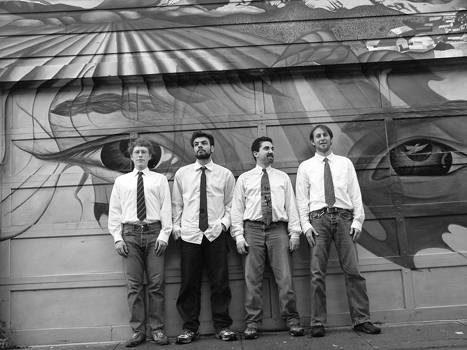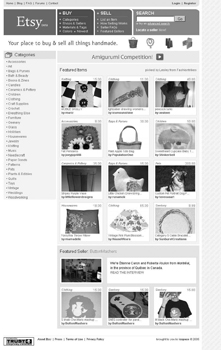How They Started (11 page)
Authors: David Lester

As the site neared launch, Rob hunted for a name for the new business. He knew he wanted it to be something short—short website addresses are easier to remember—and he wanted a made-up word around which he could build a brand.
Watching the Italian director Federico Fellini’s classic film
8½
, Rob kept hearing the actors say “etsi,” Italian for “oh yes.” He also noted that in Latin it meant “and if.” Americanized with a “y” ending, the company was christened Etsy.
In June 2005, Etsy launched as a free e-commerce site for crafters. Why? The billing system wasn’t built yet. Etsy had no way to assess, track or collect payments.
Sean had the opposite opinion from Rob’s grandpa: launch as soon as you possibly can, and add more features later.
It would be several more months before Etsy would be able to institute its initial fees: 10 cents per listing and a 3.5 percent fee on items sold. For now, crafters could get onto the site, put up listings and pictures of their wares, and sell them. Search tools for customers were rudimentary. Still, Etsy was up and going, and crafters took notice immediately.
“The biggest landmark is after we launched, we actually saw someone list something,” Haim recalls. “Holy shit, somebody actually used us! And later on, somebody actually bought something. That was a real moment for me. From there, it just grew and grew.”
As crafters signed on and began to use the site, the team continued to work madly on fixing problems and adding features. For instance, sellers of vintage items wanted more categories for their wares.
The breakthrough addition was chat forums. The team had seen the power of forums on the GetCrafty site, but never imagined how crafters longed to share their problems and ideas. By the year’s end the team would be moderating 100 forum posts a day. (By 2008, it would be 15,000 posts.) Of course, managing all this took work, work, and more work for the small team.
“Our work arguably never stopped,” says Haim. “There were always improvements to make and bugs to fix. We were literally always building it.”
Quickly, it became clear that more robust search tools would be needed to sift through the growing piles of merchandise—jewelry and sock puppets, paintings and hand-sewn pillows. Rob knew a visual artist in New Mexico, Jared Tarbell, who was adept at working in the graphics program Adobe Flash. Jared had been hesitant to join before the launch, but once the site was up, he began working remotely from New Mexico on new search features.
His first search tool allowed users to search for items by color, a useful feature for decorators. Etsy ended up patenting the technology, which is used by many retailers today. Other features added later were more whimsical, such as one that would select Etsy sellers who were celebrating their birthday. A geolocator was also added so shoppers could view goods from a particular country or city.

Rob, Chris, Haim and Jared in California, circa 2006.
“Our work arguably never stopped,” says Haim. “There were always improvements to make and bugs to fix. We were literally always building it.”
While the tech team had their heads down, Rob had his eye on the big picture. He considered Etsy’s marketplace nothing short of revolutionary. He wanted it to be a tool to enable consumers to abandon mass-produced, cheap goods in favor of getting to know small merchants and purchasing their wares. On the seller side, more people would be empowered to make an independent living.
“Etsy is about offering viable alternatives to mass-produced objects in the world marketplace,” he told the
Financial Times.
While it wasn’t done intentionally, launching as a free site had its advantages in attracting crafters. Once the pay model was introduced several months later, many users would accept the fees and continue to be Etsy sellers.
By the end of 2005, several thousand crafters had sold $170,000 of goods on Etsy. Of course, there was little profit in it for the team, since the site was free for about half of its six months of operation.
It wasn’t clear in these early days if Etsy would grow large enough to become profitable. Most of the products were low-priced, so Etsy’s commissions were small. But crafters loved the site, and shoppers were buying.
Now that the site was up and enjoying modest success, the budding company grappled with growing pains. As more users came on, the site developed problems and sometimes crashed. When it was down or a feature didn’t work, users would see a cartoon of a flaming Haim known as “Haim on Fire” with the caption, “Don’t worry—Haim’s working on it!” After one major 2007 outage, Etsy crafters expressed gratitude for Haim’s round-the-clock efforts to restore the site by making crafts incorporating the Haim on Fire image.

The cartoon Etsy put up when their website crashed.
Etsy needed more powerful computer servers, more staff—and more money. Fortunately, word had spread rapidly about the little startup. The tech press loved Jared’s innovative Flash features, while crafting magazines printed glowing tales of crafters who’d seen success on Etsy and been able to turn crafting into a full-time business.
To connect with Silicon Valley venture capitalists, Rob laid plans to visit California. Rob’s Brooklyn pal and investor Sean Meenan came along as Rob’s wingman.
Rob had contacted Flickr co-founder Stewart Butterfield via email, expressing his admiration for Flickr and asking him to take a look at Etsy. He did, and liked what he saw. Flickr had recently sold to Yahoo! for a reported $30 million, putting Stewart and his co-founder/spouse Caterina Fake in the investing business. Both were enthusiastic about Etsy and would take the lead in helping secure Etsy’s first round of venture funding.
Through Fake and Delicious founder Joshua Schachter, whom Rob had met at a New York party, Rob met a couple of heavy-hitting venture capitalists at Union Square Ventures: Fred Wilson and Albert Wenger (who had briefly been president of Delicious).
Together, these investors committed $1 million in November 2006 to Etsy in its “Series A” venture funding round. Union Square would invest over $3 million more the following year. The negotiation was a triumph for Rob, who was nervous pitching Union Square as he’d heard the firm wanted at least a 20 percent stake to invest in a startup. Rob didn’t want to give up that much ownership.
He boldly offered Union just 1 percent of the company, take it or leave it. Wilson immediately agreed, and Union Square was in. Albert says investing in Etsy was a no-brainer.
“They didn’t have to pitch,” he says. “I could go on the site and see people were genuinely excited to have a marketplace just for them. The existing venues—craft fairs and consignment shops—were incredibly inefficient. I thought, ‘This is what the Internet is for—connecting people and enabling this kind of commerce that has a personal component to it.’ Plus, they had youthful enthusiasm aplenty.”
The money was raised to fund “Etsy 2.0,” a major upgrade of the site. To stay close to their new funders, the Etsy trio rented a house in San Francisco’s Noe Valley area and set to work coding the new version.
One bright spot in the frantic money-raising and site-rebuilding of 2006 was that Etsy doubled its listing rate to 20 cents. Haim says there was some griping from sellers, but as the fees on Etsy were still substantially lower than eBay’s—and far simpler to understand—most accepted it.
During this time, Etsy picked up a marketing manager, former rock-band member Matt Stinchcomb. To this point, Etsy had put almost no money into marketing. Matt created “street teams,” bringing together Etsy sellers by market area or interest group. The groups offered support for crafters and put on local craft fairs and how-to events. This promotional method got the word out about Etsy and built crafters’ loyalty to the brand.
Etsy closed out the year having handled $3.8 million in sales for its merchants. But the Brooklynites didn’t take to California, and returned home after just a month in the Noe Valley house. Soon Chris and Haim would be coding at Haim’s house, with Chris crashing on the uncomfortable couch they dubbed “the spine-crusher.”
The team continued on in this way until Etsy got its first Brooklyn office in 2007. It was a heady time: the company had just seen its millionth sale, and two million items would be sold before the end of the year. With its first real office, Rob started Etsy Labs, installing silk-screening machines and other craft supplies and holding events where crafters would create goods on site.
The company also added a new revenue stream to its business model, offering sellers the chance to pay a $7 fee to have their product featured prominently in Etsy’s “Showcase.”
In Rob’s view, Etsy sellers were like the tiny fish that band together to repel scary big fish in the children’s story
Swimmy
, by Leo Lionni. Bringing crafters together on the site, he hoped, would enable them to better compete with big-box stores.
Some crafters found a dark side to being an Etsy seller, though. Crafters reported toiling 14-hour days at what amounted to less than minimum wage to create their wares. On the flip side, success could get you banned from Etsy. The site’s rule was that all goods must be handmade. If sellers became popular and wanted to make more goods than they could personally handcraft, they had to leave the site.
Sales volume skyrocketed in the next few years, hitting $26 million in 2007 and $87.5 million in 2008. With growth, though, came chaos. The company staff mushroomed to 60 without a planned structure for how they would interact. Silos developed. Teams lost focus. The site struggled to keep up with crafters’ demands for more features.
At the same time, the site’s explosive growth drew more interest from funders. Etsy was able to raise a much larger funding round in 2007: $27 million from Accel Partners, Acton Capital Partners, Hubert Burda Media, and Union Square.
With investors looking on and increasingly anxious for the site to turn a profit, Etsy needed someone more seasoned to create a stronger corporate structure. Former Amazon and NPR Digital Media manager Maria Thomas was hired as chief operating officer. Maria was quickly elevated to CEO, with Rob stepping away from day-to-day responsibilities to focus on creating a charity that would help empower crafters.
The leadership change was a breaking point for Chris and Haim, who were burned out from the years of long hours. In particular, Haim had been working in the company’s rented New Jersey data center under hellish conditions, locked alone inside a security cage in a noisy, cold, poorly lit, windowless cavern he dubbed “a raver’s prison.” The two identified pressing problems and told Maria about their proposals to solve them, and were rebuffed. They asked to do research-and-development work for new Etsy projects. Again, the answer was no.
“She said, ‘I have no interest in any of this—I’m bringing in all my own people,’” Haim recalls. “It was time for us to go, because this was never going to work. If you don’t have board seats, you don’t have power—that’s the most valuable lesson we learned.”

